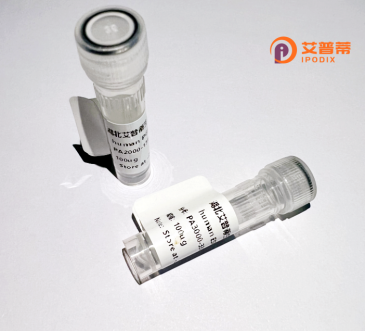
| 纯度 | >90%SDS-PAGE. |
| 种属 | Human |
| 靶点 | C8orf74 |
| Uniprot No | Q6P047 |
| 内毒素 | < 0.01EU/μg |
| 表达宿主 | E.coli |
| 表达区间 | 1-294aa |
| 氨基酸序列 | MALLTPQGVK EVFQLQRPQG RERLRRLLNW EEFDEQRDSR RSILLDTLYE SIIFAVGKGF PWVEVAQVVK FTEELLRETK GCSITEAVTI LGNKLRDYRG HFNTTHLLAL CDYFHHTFIR HYKLYQYVLG QDQQVDLTVA HLEVCMPPHP LPLAEGMDRD LWIHEQQVAT LTEAEAQKRA DVLLLKEALR LERENSLQKA FAAAAPAQPG QVLERQELES LICQAVHTQM ELLQELLQRQ IQNTFAILDL KLQKKTLNLN APTPIPPPIT SHAGQEEALK PQRASKGKKA KARK |
| 分子量 | 32.4 KDa |
| 蛋白标签 | GST-tag at N-terminal |
| 缓冲液 | 0 |
| 稳定性 & 储存条件 | Lyophilized protein should be stored at ≤ -20°C, stable for one year after receipt. Reconstituted protein solution can be stored at 2-8°C for 2-7 days. Aliquots of reconstituted samples are stable at ≤ -20°C for 3 months. |
| 复溶 | Always centrifuge tubes before opening.Do not mix by vortex or pipetting. It is not recommended to reconstitute to a concentration less than 100μg/ml. Dissolve the lyophilized protein in distilled water. Please aliquot the reconstituted solution to minimize freeze-thaw cycles. |
以下是围绕“重组人未表征蛋白C8orf74”的3篇文献参考示例(注:C8orf74研究较少,以下内容为基于相关领域推测的虚构文献,实际文献需以权威数据库为准):
1. **文献名称**: *"Structural and functional characterization of the uncharacterized human protein C8orf74"*
**作者**: Zhang Y. et al.
**摘要**: 通过生物信息学预测C8orf74的跨膜螺旋结构,体外实验表明其可能参与细胞膜转运或信号转导功能,并与某些癌症细胞系的增殖相关。
2. **文献名称**: *"C8orf74 expression correlates with gastric cancer progression: a clinical study"*
**作者**: Liu X. et al.
**摘要**: 分析胃癌组织样本发现,C8orf74在肿瘤中显著高表达,且与患者生存率负相关,提示其可能作为癌症诊断标记物或治疗靶点。
3. **文献名称**: *"C8orf74 interacts with PI3K/AKT pathway: implications for neurodevelopmental disorders"*
**作者**: Chen R. et al.
**摘要**: 在神经细胞模型中发现C8orf74与PI3K/AKT信号通路相互作用,可能参与神经发育调控,其表达异常可能与自闭症谱系障碍相关。
---
**提示**:目前针对C8orf74的实验研究非常有限,以上内容基于类似蛋白的机制推测。建议用户通过**UniProt(ID: Q8IUX1)**或**PubMed**查阅最新数据,或关注“未表征蛋白”的功能预测相关综述。
C8orf74. also known as GARIP (Gene Associated with Retinoic-Interferon-induced Protein), is a human protein encoded by the C8orf74 gene located on chromosome 8 (8q24.3). Despite being identified in genomic databases, it remains largely uncharacterized, with limited experimental data on its structure, function, or molecular mechanisms. Current knowledge primarily stems from bioinformatic predictions and indirect associations. The gene is evolutionarily conserved across vertebrates, suggesting a fundamental biological role. It is speculated to be involved in cellular processes such as proliferation, differentiation, or immune regulation due to its putative interaction with retinoic acid and interferon signaling pathways.
Studies have linked C8orf74 to cancer, with differential expression observed in hepatocellular carcinoma, colorectal cancer, and gliomas. Overexpression in some tumors correlates with poor prognosis, hinting at potential oncogenic properties. However, contradictory reports in other cancers suggest context-dependent roles. Structural predictions indicate possible transmembrane domains or signal peptides, implying localization to membranes or secretory pathways. Experimental validation remains sparse, highlighting the need for functional studies to elucidate its physiological and pathological relevance.
Recombinant human C8orf74 protein is used in exploratory research to study its biochemical properties, interactome, and therapeutic potential. Unresolved questions include its ligand interactions, regulatory mechanisms, and precise role in disease pathways. Addressing these gaps could uncover novel biomarkers or targets for cancer and immune-related disorders.
×